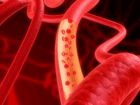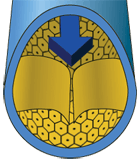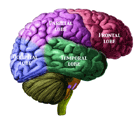 NRx (formerly known as Net Results Express) is UHN's monthly research e-newsletter. Through NRx you can read about ongoing research at our five research institutes, the Ontario Cancer Institute (OCI), the Toronto General Research Institute (TGRI), the Toronto Western Research Institute (TWRI), the Toronto Rehabilitation Institute (TRI) and the Techna Institute (Techna).
NRx (formerly known as Net Results Express) is UHN's monthly research e-newsletter. Through NRx you can read about ongoing research at our five research institutes, the Ontario Cancer Institute (OCI), the Toronto General Research Institute (TGRI), the Toronto Western Research Institute (TWRI), the Toronto Rehabilitation Institute (TRI) and the Techna Institute (Techna).
In this issue you can read about research in:
- Genes that regulate the development of blood cells
- Side effects of an experimental therapy for colorectal cancer
- The control of inflammation of epithelial cells in vascular disease
- The predictiveness of brain signal variation in memory performance
- Resistance exercise in the recovery of cognition after stroke
We hope that you will find NRx informative and helpful. If you have feedback or questions, please contact www@uhnresearch.ca.
Christopher J. Paige, PhD, FCAHS
Vice President, Research
University Health Network

UHN’s 2012 Inventor of the Year award was presented to UHN Medical Physicist and Techna Faculty Dr. Thomas Purdie. The award, sponsored through UHN’s Technology Development and Commercialization (TDC) Office, honours a UHN researcher that has made outstanding and inventive contributions to patient-oriented biomedical research by developing technologies with commercialization potential.
The award was presented to Dr. Purdie for his role in developing software that has significantly improved the way cancer radiation therapy is delivered. Effective radiotherapy treatments use high precision doses of radiation to kill tumour cells while minimizing any damage to adjacent healthy cells. Therefore, each patient requires a customized treatment map that directs radiation to where it is required. Previously this process was performed manually, which was extremely time-consuming because tumours often have complex shapes. Dr. Purdie developed software that automates the analysis of diagnostic images, and maps the tumour in a fraction of the time compared to traditional methods. Implementation of this system not only reduced the treatment planning process from two hours to six minutes, it also allowed breast cancer patients to be imaged, planned and treated in the same day, and typically in less than three hours.
Dr. Purdie’s software, which was developed with the support of the Princess Margaret Cancer Foundation, has now been used to treat over 1700 patients at the Princess Margaret Cancer Centre. The technology has been licensed to RaySearch Laboratories through UHN’s TDC Office and will be made available to radiation treatment clinics around the world by the end of the year. Congratulations Dr. Purdie.

Blood cell development is controlled by a complex network (illustrated above) of proteins that regulate the expression of other genes.
Blood production goes through multiple stages of development starting with hematopoietic stem cells (HSCs) which transition into increasingly more specialized cells—called progenitors—that eventually develop into blood cells. Scientists have been able to identify some of the individual genes that regulate this process in humans; however, a comprehensive examination of the network of genes involved had not been performed.
In a recently published study, OCI Senior Scientist Dr. John Dick examined the expression of more than 12,000 genes in HSCs and their progeny during the early stages of human blood development. Although many genes were expressed similarly among the different cell types, there were very clear differences between gene expression in stem cells and their progeny. In particular, Dr. Dick and his team were able to identify three novel genes involved in the formation of a type of immune cell known as a B cell, which produced antibodies against infectious agents.
Explains Dr. Dick, "Our studies provide a wealth of data on gene expression patterns in HSCs and their progeny. Integrating these studies with other genomic studies will shed further light on how blood cells are generated and help in the development of new clinical therapies."
This work was supported by the Swiss National Science Foundation, Roche, the Fondation Suisse de Bourses en Médecine et Biologie, the Swedish Research Council, Genome Canada through the Ontario Genomics Institute, the Ontario Institute for Cancer Research, the Canadian Institutes of Health Research, the Canada Foundation for Innovation, The Princess Margaret Cancer Foundation, the Terry Fox Research Institute, the Canadian Cancer Society Research Institute and the Ontario Ministry of Health and Long-Term Care. J. Dick is a Tier 1 Canada Research Chair in Stem Cell Biology.
The transcriptional architecture of early human hematopoiesis identifies multilevel control of lymphoid commitment. Laurenti E, Doulatov S, Zandi S, Plumb I, Chen J, April C, Fan JB, Dick JE. Nature Immunology. 2013 May 69. [Pubmed abstract]

Brivanib inhibits the growth of new blood vessels, depriving tumours of oxygen and nutrients.
Colorectal cancer (CRC) that is resistant to chemotherapy and has spread to other organs or sites in the body (metastatic) is an incurable form of cancer, with a survival time of less than a year. There is a need for better therapies for this form of CRC. One potential approach is to block the growth factors that promote the formation of blood vessels needed for tumours to grow. OCI Clinician Scientist Dr. Lillian Siu recently led a multicentre phase III clinical trial investigating cetuximab in combination with a new drug brivanib—a potent inhibitor of blood vessel growth factors—in metastatic CRC patients.
The drug combination did extend the amount of time patients had without their cancer spreading, but overall survival was not significantly affected by the addition of brivanib. The combination also increased the number of adverse side effects, such as nausea and abdominal pain, which necessitated lowering the dosage for many patients.
The study will provide valuable data for understanding metastatic CRC. Further analysis may reveal a subgroup of patients that did respond to the therapy, and biomarkers or blood tests that could be used to identify them for future studies.
This work was supported by the National Cancer Institute of Canada Clinical Trials Group.
Phase III randomized, placebo-controlled study of cetuximab plus brivanib alaninate versus cetuximab plus placebo in patients with metastatic, chemotherapy-refractory, wild-type K-RAS colorectal carcinoma: The NCIC Clinical Trials Group and AGITG CO.20 Trial. Siu LL, Shapiro JD, Jonker DJ, Karapetis CS, Zalcberg JR, Simes J, Couture F, Moore MJ, Price TJ, Siddiqui J, Nott LM, Charpentier D, Liauw W, Sawyer MB, Jefford M, Magoski NM, Haydon A, Walters I, Ringash J, Tu D, O'Callaghan CJ. Journal of Clinical Oncology. 2013 May 20. [Pubmed abstract]

In atherosclerosis, the endothelium becomes inflamed and this leads to the development of an atherosclerotic plaque (yellow).
The endothelium is a layer of cells that line the inside of blood vessels. Inappropriate inflammation of the endothelium plays a role in the development of vascular diseases, such as atherosclerosis. Identifying the precise mechanisms through which endothelial cells become inflamed may provide new therapeutic targets for the treatment of vascular diseases. TGRI Scientist Dr. Jason Fish and TGRI Senior Scientist Dr. Myron Cybulsky have detailed the role for microRNA, a class of molecules that control gene expression, in inflammation.
When endothelial cells are exposed to molecules that promote inflammation, microRNA-146 (miR-146) was shown to increase in quantity and repress the expression of genes involved in pro-inflammatory responses. "miR-146 prevents inflammation and may play a protective role against the development of atherosclerosis," says Dr. Fish. "In addition to miR-146 being an attractive target for developing new therapies, changes in the levels of miR-146 may predispose individuals to the development of vascular diseases."
This work was supported by the Heart and Stroke Foundation of Ontario, the Canadian Institutes of Health Research, the Heart and Stroke Foundation of Canada, the Ontario Ministry of Economic Development and Innovation and the Canada Foundation for Innovation. Dr. Fish is a Tier 2 Canada Research Chair in Vascular Cell and Molecular Biology
MicroRNA-146 represses endothelial activation by inhibiting pro-inflammatory pathways. Cheng HS, Sivachandran N, Lau A, Boudreau E, Zhao JL, Baltimore D, Delgado-Olguin P, Cybulsky MI, Fish JE. EMBO Molecular Medicine. 2013 June 3. [Pubmed abstract]

The temporal lobe of the human brain (green) contains structures like the hippocampus which are essential for memory storage.
The human brain is a complex system and considerable effort has been made in trying to identify a reliable biomarker of how changes in brain structure may affect function (also called functional integrity). Theoretical research suggests that variability in the physiological signals in the brain is a critical parameter that reflects processing capacity and thus the degree to which the brain can respond flexibly to the environment. A recent study from TWRI Senior Scientist Dr. Mary Pat McAndrews and former postdoctoral fellow Dr. Andrea Protzner (now at the University of Calgary) sheds light on how signal variability may account for differences in functional capacity in patients with medial temporal lobe epilepsy, where damage to the medial temporal lobe affects the ability to acquire and retrieve memories.
Using functional magnetic resonance imaging, they showed that signal variability in a network including the left hippocampus predicted verbal retention. This relationship was similar across a range of cognitive tasks measured during scanning including visual fixation, word generation and autobiographical recall. "These findings provide a powerful validation of the concept that brain signal variability reflects functional integrity," says Dr. McAndrews. "Moreover, this measure is a robust biomarker in this clinical setting because it reveals the same pattern regardless of the task or cognitive challenge."
This work was supported by the James S. McDonnell Foundation and the Canadian Institutes of Health Research.
Characterizing functional integrity: intraindividual brain signal variability predicts memory performance in patients with medial temporal lobe epilepsy. Protzner AB, Kovacevic N, Cohn M and McAndrews MP. Journal of Neuroscience. 2013 June 5. [Pubmed abstract]

Resistance provided by dumbbells, exercise bands or body weight is used to build muscle in resistance training.
Improving brain function after stroke is an important goal towards rehabilitation. While studies have shown that aerobic exercise, such as walking and cycling, can enhance motor function, it has been suggested that building muscle mass (known as fat-free mass) may promote neurological function. Thus, exercise programs incorporating weight or resistance training may be particularly beneficial for patients that have suffered a stroke. To explore this possibility TRI Senior Scientist Dr. Dina Brooks, who is also a Professor in the Department of Physical Therapy at the University of Toronto and a Senior Scientist at West Park HealthCare Centre, and PhD student Susan Marzolini led a study that enrolled 41 stroke patients in a combined aerobic and resistance training program.
Patients attended weekly 90 minute exercise classes and completed supplemental at-home aerobic and resistance training sessions. After the 6 month study, close to half of the participants showed significant improvements in mental function, such as concentration, visual thinking, planning skills and verbal reasoning. Dr. Brooks explains, "These results have linked—for the first time in stroke patients—enhanced cognitive function with increased fat-free mass in the context of exercise training, further supporting the idea that resistance training may be beneficial for poststroke recovery."
This work was supported by funding from the Heart and Stroke Foundation Centre for Stroke Recovery and the Ontario Ministry of Health and Long-Term Care through the Provincial Rehabilitation Research Program. D. Brooks is a Tier 2 Canada Research Chair in Rehabilitation for Chronic Obstructive Pulmonary Disease.
The effects of an aerobic and resistance exercise training program on cognition following stroke. Marzolini S, Oh P, McIlroy W, Brooks D. Neurorehabilation & Neural Repair. 2013 June. [Pubmed abstract]
 The Canadian Cancer Society has named OCI Scientist Dr.
The Canadian Cancer Society has named OCI Scientist Dr.  OCI Senior Scientist Dr.
OCI Senior Scientist Dr.